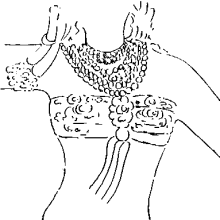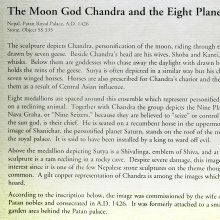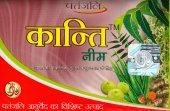Kanti, Kaṇṭī, Kānti, Kamti, Kantī: 31 definitions
Introduction:
Kanti means something in Hinduism, Sanskrit, Buddhism, Pali, Marathi, Jainism, Prakrit, Hindi, biology, Tamil. If you want to know the exact meaning, history, etymology or English translation of this term then check out the descriptions on this page. Add your comment or reference to a book if you want to contribute to this summary article.
Images (photo gallery)
In Hinduism
Shaktism (Shakta philosophy)
Source: Wisdom Library: ŚāktismKānti (कान्ति, “beauty, splendour”):—Name of one of the sixty-four mātṛs to be worshipped during Āvaraṇapūjā (“Worship of the Circuit of Goddesses”, or “Durgā’s Retinue”), according to the Durgāpūjātattva. They should be worshipped with either the five upācāras or perfume and flowers.
Her mantra is as follows:
ॐ कान्त्यै नमः
oṃ kāntyai namaḥ.

Shakta (शाक्त, śākta) or Shaktism (śāktism) represents a tradition of Hinduism where the Goddess (Devi) is revered and worshipped. Shakta literature includes a range of scriptures, including various Agamas and Tantras, although its roots may be traced back to the Vedas.
Pancaratra (worship of Nārāyaṇa)
Source: Wisdom Library: PāñcarātraKānti (कान्ति, “beauty, loveliness”):—One of the twenty-four emanations of Lakṣmī accompanying Nārāyaṇa. This particular manifestation couples with his counterpart form called Nārāyaṇa and together they form the second celestial couple. Lakṣmī represents a form of the Goddess (Devī) as the wife of Viṣṇu, while Nārāyaṇa represents the personification of his creative energy, according to the Pāñcarātra literature.

Pancaratra (पाञ्चरात्र, pāñcarātra) represents a tradition of Hinduism where Narayana is revered and worshipped. Closeley related to Vaishnavism, the Pancaratra literature includes various Agamas and tantras incorporating many Vaishnava philosophies.
Purana and Itihasa (epic history)
Source: archive.org: Puranic EncyclopediaKānti (कान्ति).—A city in ancient India. (Mahābhārata Bhīṣma Parva, Chapter 9, Verse 40).
Source: archive.org: Shiva Purana - English TranslationKānti (कान्ति) refers to “splendour” and is used to describe Goddess Umā, according to the Śivapurāṇa 2.3.3.—Accordingly, as the Gods eulogized Umā (Durgā/Satī) with devotion:—“[...] you are sleep in all living beings; you are hunger, satiety, thirst, splendour (i.e., kānti), brilliance and contentment. You are the delighter of every one for ever. To those who perform meritorious actions you are the goddess of fortune. To the sinners you are the eldest sister, the deity of Ignominy; you are peace for the universe, and the mother sustaining lives”.
Source: Cologne Digital Sanskrit Dictionaries: The Purana Index1a) Kānti (कान्ति).—A śakti.*
- * Brahmāṇḍa-purāṇa IV. 44. 72.
1b) A Brahma kalā.*
- * Brahmāṇḍa-purāṇa IV. 35. 94.

The Purana (पुराण, purāṇas) refers to Sanskrit literature preserving ancient India’s vast cultural history, including historical legends, religious ceremonies, various arts and sciences. The eighteen mahapuranas total over 400,000 shlokas (metrical couplets) and date to at least several centuries BCE.
Natyashastra (theatrics and dramaturgy)
Source: Wisdom Library: Nāṭya-śāstra1) Kānti (कान्ति, “loveliness”) refers to one of the ten merits (guṇa) of a dramatic play (kāvya), according to Nāṭyaśāstra chapter 17. They are characterised by their sweetness and depth of meaning.
2) Kānti (कान्ति, “charm”) refers to one of the ten “ involuntary graces” of women (svābhāvikā), according to the Nāṭyaśāstra chapter 24. These involuntary (spontaneous) graces, represent one of the three aspects of graces (alaṃkāra) which forms which forms the support of sentiments (rasa) in drama. These involuntary graces (such as kānti) are defined according to the science of sāmānyābhinaya, or “harmonious representation”.
According to the Nāṭyaśāstra, “beauty which is full of a lover’s passion, is called ‘charm’ (kānti)”.
Source: archive.org: Natya ShastraKānti (कान्ति, “loveliness”).—One of the ten guṇas (merits) of a kāvya (dramatic play);—Description of kānti: When a composition gives delight to the ears as well as to the mind on account of its well-put-together words, it is an instance of Loveliness (kānti).

Natyashastra (नाट्यशास्त्र, nāṭyaśāstra) refers to both the ancient Indian tradition (shastra) of performing arts, (natya—theatrics, drama, dance, music), as well as the name of a Sanskrit work dealing with these subjects. It also teaches the rules for composing Dramatic plays (nataka), construction and performance of Theater, and Poetic works (kavya).
Ayurveda (science of life)
Nighantu (Synonyms and Characteristics of Drugs and technical terms)
Source: WorldCat: Rāj nighaṇṭuKaṇṭī (कण्टी) is another name for Apāmārga, a medicinal plant identified with Achyranthes aspera Linn. (“prickly chaff-flower”) from the Amaranthaceae or “amaranth” family of flowering plants, according to verse 4.88-91 of the 13th-century Raj Nighantu or Rājanighaṇṭu. The fourth chapter (śatāhvādi-varga) of this book enumerates eighty varieties of small plants (pṛthu-kṣupa). Together with the names Kaṇṭī and Apāmārga, there are a total of twenty-three Sanskrit synonyms identified for this plant.
Unclassified Ayurveda definitions
Source: archive.org: Vagbhata’s Ashtanga Hridaya Samhita (first 5 chapters)Kānti (कान्ति) refers to “beauty”, as mentioned in verse 5.37-39 of the Aṣṭāṅgahṛdayasaṃhitā (Sūtrasthāna) by Vāgbhaṭa.—Accordingly, “[...] [ghee is] recommended for [...] children, old people, those desirous of offspring, beauty [viz., kānti], great tenderness, and voice, [...]: ghee [viz., ghṛta] (is) possessed of a thousand powers (and), by its (many) ways of application, productive of a thousand effects”.
Note: Prajā (“offspring”) has been translated by bu (“son”), kānti (“beauty”) by mdaṅs bzaṅ (“fair complexion”), and saukumārya (“great tenderness”) by rab gźon (“great youthfulness”) (gźon-pa being so far attested only as an adjective). The following arthin (“desirous of”), which in Sanskrit belongs to prajā, kanti, saukumārya, and svara alike, has in Tibetan been confined to prajā.

Āyurveda (आयुर्वेद, ayurveda) is a branch of Indian science dealing with medicine, herbalism, taxology, anatomy, surgery, alchemy and related topics. Traditional practice of Āyurveda in ancient India dates back to at least the first millenium BC. Literature is commonly written in Sanskrit using various poetic metres.
Jyotisha (astronomy and astrology)
Source: Wisdom Library: Brihat Samhita by VarahamihiraKānti (कान्ति) or Kāntibhṛt refers to “that which has a certain color”, according to the Bṛhatsaṃhitā (chapter 9), an encyclopedic Sanskrit work written by Varāhamihira mainly focusing on the science of ancient Indian astronomy astronomy (Jyotiṣa).—Accordingly, “If Venus (śukra) should be of the colour of fire, there will be fear from fire; if of blood colour, there will be wars in the land; if of the colour of burnished gold, there will be disease; if green, there will be asthmatic complaints; if ashy-pale or black, there will be drought in the land. If Venus should be of the colour of coagulated milk, of the white water lily, or of the moon [i.e., kānti-bhṛt—dadhikumudaśaśāṅkakāntibhṛt], or if her course be direct, or if she should be the successful planet in conjunctions, mankind will enjoy the happiness of Kṛtayuga”.

Jyotisha (ज्योतिष, jyotiṣa or jyotish) refers to ‘astronomy’ or “Vedic astrology” and represents the fifth of the six Vedangas (additional sciences to be studied along with the Vedas). Jyotisha concerns itself with the study and prediction of the movements of celestial bodies, in order to calculate the auspicious time for rituals and ceremonies.
Shaivism (Shaiva philosophy)
Source: Brill: Śaivism and the Tantric TraditionsKānti (कान्ति) refers to “one’s beauty”, according to the 13th-century Matsyendrasaṃhitā: a Kubjikā-Tripurā oriented Tantric Yoga text of the Ṣaḍanvayaśāmbhava tradition from South India.—Accordingly, “[The intercourse (saṃga)]:—[...] The Yogin who has had sex with Māyā should rub his semen mixed with gold, camphor and saffron on his own body: [his] beauty (kānti) will become moon-like. [...]
Source: SOAS University of London: Protective Rites in the Netra TantraKānti (कान्ति) refers to “charming”, according to the Netratantra of Kṣemarāja: a Śaiva text from the 9th century in which Śiva (Bhairava) teaches Pārvatī topics such as metaphysics, cosmology, and soteriology.—Accordingly, [verse 13.1-9, while describing the appearance and worship of Viṣṇu, in the form of Nārāyaṇa]—“[...] Or, he should meditate [on Nārāyaṇa] atop Garuḍa, Śrī at his side. [He should visualize Viṣṇu] very white and beautiful [with] three faces [that] resemble the moon, six arms, decorated like Varāha Hari, [his hands] endowed with [the shapes of] wish-granting and protection. Śrī is of the same color and holds the same weapons, suitably beautiful and charming (lāvaṇya-kānti-sadṛśī) before the eyes of Devadeva. [...]”.

Shaiva (शैव, śaiva) or Shaivism (śaivism) represents a tradition of Hinduism worshiping Shiva as the supreme being. Closely related to Shaktism, Shaiva literature includes a range of scriptures, including Tantras, while the root of this tradition may be traced back to the ancient Vedas.
Yoga (school of philosophy)
Source: ORA: Amanaska (king of all yogas): A Critical Edition and Annotated Translation by Jason BirchKānti (कान्ति) is another name for Snigdhatā, which refers to “lustre of body”, and represents one of the various signs and paranormal powers (siddhi) experienced by the Yoga practicioner, according to the Amanaska Yoga treatise (presented in the form of a dialogue between Īśvara and Vāmadeva).—The last fifty-two verses of the Amanaska’s first chapter describe a temporal sequence of psychosomatic signs and paranormal powers (siddhi) brought about by absorption (laya). [...] It informs practitioners of the initial experiences they may have while immersed in absorption [e.g., Suppleness and lustre (snigdhatā) of body], and thus provides them with some idea of their progress in the practice, [...]. On lustre, which is expressed as snigdhatā in the Amanaska, but dīpti in the Dattātreyayogaśāstra 68; Yogayājñavalkya 5.21 and Śāṇḍilyopaniṣat 5.4 and kānti in the Yogaśāstra 5.24; Haṭhapradīpikā 2.19, 2.28; Śivasaṃhitā 3.29; Haṭharatnāvalī 1.49; Gheraṇḍasaṃhitā 1.43, etc.

Yoga is originally considered a branch of Hindu philosophy (astika), but both ancient and modern Yoga combine the physical, mental and spiritual. Yoga teaches various physical techniques also known as āsanas (postures), used for various purposes (eg., meditation, contemplation, relaxation).
Biology (plants and animals)
Source: Wisdom Library: Local Names of Plants and DrugsKanti [கந்தி] in the Tamil language is the name of a plant identified with Areca catechu L. from the Arecaceae (Palm) family. For the possible medicinal usage of kanti, you can check this page for potential sources and references, although be aware that any some or none of the side-effects may not be mentioned here, wether they be harmful or beneficial to health.
Source: Google Books: CRC World Dictionary (Regional names)1) Kanti in India is the name of a plant defined with Acacia catechu in various botanical sources. This page contains potential references in Ayurveda, modern medicine, and other folk traditions or local practices It has the synonym Mimosa catechu L.f. (among others).
2) Kanti is also identified with Acacia ferruginea It has the synonym Mimosa ferruginea Roxb. (etc.).
3) Kanti is also identified with Acacia torta It has the synonym Acacia torta Craib (etc.).
4) Kanti is also identified with Achyranthes aspera It has the synonym Centrostachys indica Standl. (etc.).
5) Kanti is also identified with Areca catechu It has the synonym Areca nigra Giseke ex H. Wendl. (etc.).
6) Kanti is also identified with Cajanus cajan It has the synonym Phaseolus balicus L. (etc.).
7) Kanti is also identified with Ipomoea alba It has the synonym Calonyction aculeatum var. lobatum (H. Hallier) C.Y. Wu (etc.).
8) Kanti is also identified with Pedalium murex It has the synonym Rogeria microcarpa Klotzsch (etc.).
9) Kanti is also identified with Pisum sativum It has the synonym Lathyrus oleraceus Lam. (etc.).
10) Kanti is also identified with Shorea assamica It has the synonym Shorea assamica subsp. yingjiangensis Y.K. Yang & J.K. Wu (etc.).
11) Kanti is also identified with Tribulus terrestris It has the synonym Tribulus terrestris var. sericeus Andersson ex Svens., nom. illeg. (etc.).
Example references for further research on medicinal uses or toxicity (see latin names for full list):
· Cytologia (1976)
· Cytologia (1999)
· Agric. Res. Rep. Center Agric. Publishing Doc. (1983)
· Research Bulletin (1970)
· Jap. J. Genet. (1975)
· Species Plantarum.
If you are looking for specific details regarding Kanti, for example chemical composition, side effects, health benefits, diet and recipes, extract dosage, pregnancy safety, have a look at these references.

This sections includes definitions from the five kingdoms of living things: Animals, Plants, Fungi, Protists and Monera. It will include both the official binomial nomenclature (scientific names usually in Latin) as well as regional spellings and variants.
Languages of India and abroad
Pali-English dictionary
Source: BuddhaSasana: Concise Pali-English Dictionarykanti : (aor. of kantati) spined; cut; sheared; incised.

Pali is the language of the Tipiṭaka, which is the sacred canon of Theravāda Buddhism and contains much of the Buddha’s speech. Closeley related to Sanskrit, both languages are used interchangeably between religions.
Marathi-English dictionary
Source: DDSA: The Molesworth Marathi and English Dictionarykāṇṭī (कांटी) [or काटी, kāṭī].—f (kāṇṭā) A thorny tree or bush: also a detached branch of such. 2 The name of the two side-lines of the square drawn in the play āṭyā pāṭyā: the other line from end to end is pāṭī. 3 Applied to the bābhaḷa (Acacia) whilst small and young. kāṇṭī lāvaṇēṃ (gharāsa-saṃsārāsa-vyavahārāsa-rōjagārāsa) To ruin, destroy, crush. Ex. āpulyā saṃsārāsa lā- vūna kāṇṭī || āmacē pāṭhīṃ lāgalāsa kāṃ ||. kāṭyā āpalyā pōṭāvara ōḍhaṇēṃ To be ready to draw thorny bushes over one's belly--rather than not stuff it. To be very greedy or selfish. kāṭyākuṭyā f pl Thorny bushes and shrubs. Pr. durūna ḍōṅgara sājarā javaḷa gēlē kā0 Things (or matters) agreeable in the distance often show roughnesses on near approach to them. kāṇṭyā ghāsaṇēṃ with sīṃ of o. To scold roughly: also to harass, worry, torment. kāṇṭyāñcē kōlhē karaṇēṃ (To make jackals out of thorn-bushes.) To make a serious charge out of little matter. kāṇṭyāṃvarūna ōḍhaṇēṃ (To drag over thorny bushes) To worry grievously: also to scold coarsely and vehemently.
--- OR ---
kānti (कांति).—f (S) Beauty, splendor, light, lustre. 2 pop. kāntī f The exuvies or slough of a snake.
Source: DDSA: The Aryabhusan school dictionary, Marathi-Englishkāṇṭī (कांटी).—f A thorny tree or bush. kāṇṭī lavaṇēṃ Ruin, destroy.
--- OR ---
kānti (कांति).—f Beauty, lustre. The slough of a snake.
Marathi is an Indo-European language having over 70 million native speakers people in (predominantly) Maharashtra India. Marathi, like many other Indo-Aryan languages, evolved from early forms of Prakrit, which itself is a subset of Sanskrit, one of the most ancient languages of the world.
Sanskrit dictionary
Source: DDSA: The practical Sanskrit-English dictionaryKānti (कान्ति).—[kam bhāve ktin]
1) Loveliness, beauty, Me. 15; अक्लिष्टकान्ति (akliṣṭakānti) Ś.5.19.
2) Brightness, lustre, brilliance; Meghadūta 84.
3) Personal decoration or embellishment.
4) Wish, desire.
5) (In Rhet.) Beauty enhanced by love; (S. D. thus distinguishes kānti from śobhā and dīptiḥ -rūpayauvanalālityaṃ bhogādyairaṅgabhūṣaṇam | śobhā proktā saiva kānti- rmanmathāpyāyitā dyutiḥ | kāntirevātivistīrṇā dāptirityabhidhīyate 13, 131).
6) A lovely or desirable woman.
7) An epithet of Durgā.
8) A digit of the moon.
9) Name of Lakṣmī; भूषणानि महार्हाणि ददौ कान्तिः शुभां स्रजम् (bhūṣaṇāni mahārhāṇi dadau kāntiḥ śubhāṃ srajam) Bhāgavata 1.65.29.
Derivable forms: kāntiḥ (कान्तिः).
Source: Cologne Digital Sanskrit Dictionaries: Shabda-Sagara Sanskrit-English DictionaryKanti (कन्ति).—mfn. (-ntiḥ-ntiḥ-nti) Happy. E. kam and ti aff.
--- OR ---
Kānti (कान्ति).—f.
(-ntiḥ) 1. Beauty, splendor, light. 2. Female beauty. 3. Wish, desire. 4. A lovely or desirable woman. 5. Persoual decoration or embellishment. E. kam to desire or be desired, ktin aff.
Source: Cologne Digital Sanskrit Dictionaries: Benfey Sanskrit-English DictionaryKānti (कान्ति).—i. e. kam + ti, f. Beauty, [Indralokāgamana] 5, 7.
Source: Cologne Digital Sanskrit Dictionaries: Cappeller Sanskrit-English DictionaryKānti (कान्ति).—[feminine] (adj. —° [feminine] also ī) loveliness, splendour, beauty, [especially] womanly beauty, charms.
Source: Cologne Digital Sanskrit Dictionaries: Monier-Williams Sanskrit-English Dictionary1) Kanti (कन्ति):—[from kanta] a mfn. idem, [ib.]
2) [from kam] b mfn. idem, [Tārānātha tarkavācaspati’s Vācaspatyam, Sanskrit dictionary]
3) Kānti (कान्ति):—[from kānta] f. desire, wish, [cf. Lexicographers, esp. such as amarasiṃha, halāyudha, hemacandra, etc.]
4) [v.s. ...] loveliness, beauty, splendour, female beauty, personal decoration or embellishment, [Nalopākhyāna; Śakuntalā; Meghadūta; Pañcatantra; Suśruta; Kathāsaritsāgara]
5) [v.s. ...] a lovely colour, brightness (especially of the moon), [Kathāsaritsāgara]
6) [v.s. ...] (fī. ifc.), [Caurapañcāśikā]
7) [v.s. ...] (in rhetoric) beauty enhanced by love, [Vāmana’s Kāvyālaṃkāravṛtti iii, 1, 22; xxii, 14; Sāhitya-darpaṇa]
8) [v.s. ...] a lovely or desirable woman personified as wife of the moon, [Harivaṃśa 5419]
9) [v.s. ...] Name of Lakṣmī, [Bhāgavata-purāṇa x, 65, 29]
10) [v.s. ...] of Durgā, [DevīP.]
11) Kāntī (कान्ती):—[from kānta] f. Name of a town.
Source: Cologne Digital Sanskrit Dictionaries: Yates Sanskrit-English Dictionary1) Kanti (कन्ति):—[(ntiḥ-ntiḥ-nti) a. Idem.]
2) Kānti (कान्ति):—(ntiḥ) 2. f. Beauty, splendor, light; desire; ornament.
Source: DDSA: Paia-sadda-mahannavo; a comprehensive Prakrit Hindi dictionary (S)Kānti (कान्ति) in the Sanskrit language is related to the Prakrit word: Kaṃti.
[Sanskrit to German]
Sanskrit, also spelled संस्कृतम् (saṃskṛtam), is an ancient language of India commonly seen as the grandmother of the Indo-European language family (even English!). Closely allied with Prakrit and Pali, Sanskrit is more exhaustive in both grammar and terms and has the most extensive collection of literature in the world, greatly surpassing its sister-languages Greek and Latin.
Hindi dictionary
Source: DDSA: A practical Hindi-English dictionaryKanti in Hindi refers in English to:—(nf) brightness, lustre, splendour, gloss; loveliness; ~[maya/mana] bright, lustrous, glossy..—kanti (कांति) is alternatively transliterated as Kāṃti.
...
Prakrit-English dictionary
Source: DDSA: Paia-sadda-mahannavo; a comprehensive Prakrit Hindi dictionary1) Kaṃti (कंति) in the Prakrit language is related to the Sanskrit word: Kānti.
2) Kaṃti (कंति) also relates to the Sanskrit word: Krānti.
Prakrit is an ancient language closely associated with both Pali and Sanskrit. Jain literature is often composed in this language or sub-dialects, such as the Agamas and their commentaries which are written in Ardhamagadhi and Maharashtri Prakrit. The earliest extant texts can be dated to as early as the 4th century BCE although core portions might be older.
Kannada-English dictionary
Source: Alar: Kannada-English corpusKaṃṭi (ಕಂಟಿ):—[noun] a string (usu. with black glass beads) worn round the neck as an ornament; a necklace.
--- OR ---
Kaṃṭi (ಕಂಟಿ):—[adjective] having (many) thorns.
--- OR ---
Kaṃṭi (ಕಂಟಿ):—
1) [noun] a thorny plant having many stems branching out low instead of one main stem or trunk; a thorny shrub.
2) [noun] a group of trees or other plants.
3) [noun] the tree Acacia catechu var. typica of Mimosae family.
4) [noun] a kind weapon having horn-like metal projections.
5) [noun] a village servant whose duty is to regulate and manage water supply to the irrigated lands.
6) [noun] (fig.) molestation; vexation; annoyance.
--- OR ---
Kaṃti (ಕಂತಿ):—[noun] a cow that has calved recently.
--- OR ---
Kaṃti (ಕಂತಿ):—
1) [noun] a black oil used to anoint some stone idols.
2) [noun] a female Jaina ascetic.
--- OR ---
Kāṃti (ಕಾಂತಿ):—
1) [noun] the fact of being brilliant; great brightness, radiance, intensity, splendor; brilliance.
2) [noun] a wish; a desire.
3) [noun] the quality of being attractive or fascinating; beauty.
4) [noun] personal decoration; embellishment; ornamentation.
5) [noun] one of the sixteen apparent digits of the moon.
6) [noun] a lovely or desirable woman.
7) [noun] (rhet.) the beauty enhanced by love or its treatment, a style that is regarded as merit in poetics.
Kannada is a Dravidian language (as opposed to the Indo-European language family) mainly spoken in the southwestern region of India.
Tamil dictionary
Source: DDSA: University of Madras: Tamil LexiconKaṇṭi (கண்டி) noun
1. Buffalo bull; எருமைக் கடா. [erumaig kada.] (தொல். பொ. [thol. po.] 623.)
2. Flock, herd; மந்தை. [manthai.] Local usage
3. A kind of portable hurdle, used by fishermen for catching fish in shallow waters; அடைத்து மீன்பிடிக்குங் கருவிவகை. [adaithu minpidikkung karuvivagai.] (J.)
4. See கண்டிக்கல். [kandikkal.]
--- OR ---
Kaṇṭi (கண்டி) noun < kaṇṭhikā.
1. Neck ornament; கழுத்தணிவகை. [kazhuthanivagai.]
2. Necklace of rudrākṣa beads; உருத்திராக்கமாலை. கண்டியிற் பட்ட கழுத்துடையீர் [uruthirakkamalai. kandiyir patta kazhuthudaiyir] (தேவாரம் [thevaram] 586, 6).
--- OR ---
Kaṇṭi (கண்டி) [kaṇṭittal] 11 transitive verb < khaṇḍ.
1. To reprove, chide, censure; கடிந்துகூறுதல். [kadinthuguruthal.]
2. To speak with decision, precision, impartiality; முடிவுகட்டிப்பேசுதல். [mudivugattippesuthal.] (W.)
3. To chop, mince, slash, cut into pieces; துண்டித்தல். (திவா.) [thundithal. (thiva.)]
4. To divide, parcel; பகிர்தல். [pagirthal.] (W.)
5. To grow fat; பருத்தல். ஆள் நன்றாய்க் கண்டித்திருக்கி றான். [paruthal. al nanrayk kandithirukki ran.] Local usage
--- OR ---
Kaṇṭi (கண்டி) noun < idem. See கண்டியூர். பூமன் சிரங்கண்டி (தனிப்பாடற்றிரட்டு). [kandiyur. puman sirangandi (thanippadarrirattu).]
--- OR ---
Kaṇṭi (கண்டி) noun < Marathi khaṇḍil. [Telugu: Travancore usage khaṇḍi, M. kaṇḍi.]
1. Candy, a weight, stated to be roughly equivalent to 500 lbs.; பாரமென் னும் நிறையளவு. [paramen num niraiyalavu.]
2. A unit of land, as much as will produce a candy of grain, approximately 75 acres; எழுபந்தைந்து ஏக்கருள்ள நிலவளவை. [ezhupanthainthu ekkarulla nilavalavai.]
3. A unit of capacity = 360 படி [padi] = 4 கலம்; ஒரு முகத்த லளவு. [kalam; oru mugatha lalavu.]
--- OR ---
Kaṇṭi (கண்டி) noun cf. kāṇḍēra. A species of Amaranth, Amarantus campestris; சிறுகீரை. (வைத்திய மலையகராதி) [sirugirai. (vaithiya malaiyagarathi)]
--- OR ---
Kaṇṭi (கண்டி) noun < Sinhalese Conde. Kandy, one of the ancient capital cities of Ceylon; இலங்கையின் பழமொழிைய இராசதானியுள் ஒன்று. [ilangaiyin pazhaiya irasathaniyul onru.]
--- OR ---
Kanti (கந்தி) [kantittal] 11 intransitive verb < gandha. To waft a fragrant smell; மணத்தல். தாதகித்தார் கந்தித்த மார்பன் [manathal. thathagithar kanthitha marpan] (குலோத்துங்க சோழன் [kulothunga sozhan] 291).
--- OR ---
Kanti (கந்தி) noun < gandhin.
1. Spices, aromatics; வாசனைப்பொருள். குங்கும மேனையகந்தி கள் கூட்டி [vasanaipporul. kunguma menaiyaganthi kal kutti] (கந்தபு. அவைபுகு. [kanthapu. avaipugu.] 31).
2. Areca palm. See கமுகு. கந்திகள் . . . பாளைவிரித்து [kamugu. kanthigal . . . palaivirithu] (கந்தபு. யுத்த. முதனாட். [kanthapu. yutha. muthanad.] 38).
--- OR ---
Kanti (கந்தி) noun probably from nir-granṭha. [K. kanti.] Female ascetic among the Jains; ஆரி யாங்கனை. கறந்தபாலனைய கந்தி [ari yanganai. karanthapalanaiya kanthi] (சீவகசிந்தாமணி [sivagasindamani] 2649).
--- OR ---
Kanti (கந்தி) noun probably from gandhaka.
1. Sulphur; கந்தகம். (வைத்திய மூலிகை) [kanthagam. (vaithiya muligai)]
2. A mineral poison, one of 32; கந்தகபாஷாணம். (வைத்திய மூலிகை) [kanthagapashanam. (vaithiya muligai)]
--- OR ---
Kanti (கந்தி) noun < Telugu kandi. Dhal. See துவரை. (இராஜ வைத்தியமகுடம்) [thuvarai. (iraja vaithiyamagudam)]
--- OR ---
Kanti (கந்தி) noun Emerald; மரகதம். ((சங்கத்தகராதி) தமிழ்சொல்லகராதி) [maragatham. ((sangathagarathi) thamizhsollagarathi)]
--- OR ---
Kānti (காந்தி) noun < kānti.
1. Brightness, lustre, light, glare; ஒளி. (சூடாமணிநிகண்டு) [oli. (sudamaninigandu)]
2. Beauty; அழுகு (பிங்கலகண்டு) [azhugu (pingalagandu)]
3. Ray; கிரணம். [kiranam.] (W.)
4. Heat; உஷ்ணம். (வைத்திய மூலிகை) [ushnam. (vaithiya muligai)]
5. Foliated crystallized gypsum, used as a caustic; சிலாசத்து. (வைத்திய மூலிகை) [silasathu. (vaithiya muligai)]
6. Ochre; காவிக்கல். [kavikkal.] (W.)
7. Cat's-eye; வைடூரி யம். [vaiduri yam.] (W.)
--- OR ---
Kaṇṭi (கண்டி) noun < கண்டி-. [kandi-.] Piece; துண்டு. [thundu.] Tinnevelly usage
--- OR ---
Kanti (கந்தி) noun < கந்தம். [kantham.] Asafoetida; பெருங்காயம். (நாமதீபநிகண்டு) [perungayam. (namathipanigandu)]
--- OR ---
Kānti (காந்தி) noun < kānti. (Rhetoric) A figure of speech; அணிவகை. (யாழ்ப்பாணத்து மானிப்பாயகராதி) [anivagai. (yazhppanathu manippayagarathi)]
Tamil is an ancient language of India from the Dravidian family spoken by roughly 250 million people mainly in southern India and Sri Lanka.
See also (Relevant definitions)
Starts with (+81): Kamtibhasa, Kamtidoru, Kamtiga, Kamtigedu, Kamtigudu, Kamtigumdu, Kamtihina, Kamtihinate, Kamtihine, Kamtike, Kamtimamta, Kamtimudrana, Kamtipara, Kamtirayi, Kamtistambha, Kamtisu, Kamtitva, Kamtivamta, Kamtivardhaka, Kamtividi.
Ends with (+121): Acakanti, Acuvakanti, Akanti, Akkanti, Alkanti, Anamtakamti, Anukanti, Arikkanti, Arukanti, Atikanti, Attakanti, Avakkanti, Barakanti, Bhushanakanti, Borakanti, Brihatkanti, Calakanti, Candrakanta, Candrakanti, Cantirakanti.
Full-text (+182): Kantinagari, Kamti, Suryakanti, Kantimat, Kantida, Kantibhrit, Kandi, Kanthi, Kantimuttirai, Kantimati, Kantihara, Kantikkal, Kantikara, Ratnakanti, Vanakanti, Kantikol, Kantiyeri, Kappar kaanti, Chandra kaanthi, Sut-kamti.
Relevant text
Search found 72 books and stories containing Kanti, Kaanthi, Kaanti, Kamti, Kaṃti, Kaṃṭi, Kāṃti, Kandi, Kanthi, Kaṇṭī, Kānti, Kāṇṭī, Kāntī, Kaṇṭi, Kantī; (plurals include: Kantis, Kaanthis, Kaantis, Kamtis, Kaṃtis, Kaṃṭis, Kāṃtis, Kandis, Kanthis, Kaṇṭīs, Kāntis, Kāṇṭīs, Kāntīs, Kaṇṭis, Kantīs). You can also click to the full overview containing English textual excerpts. Below are direct links for the most relevant articles:
Mudrarakshasa (literary study) (by Antara Chakravarty)
1. Guṇa: It’s classification and components < [Chapter 5 - Adoption of Style and Language in Mudrārākṣasa]
2. The theory of rīti < [Chapter 5 - Adoption of Style and Language in Mudrārākṣasa]
Brihad Bhagavatamrita (commentary) (by Śrī Śrīmad Bhaktivedānta Nārāyana Gosvāmī Mahārāja)
Verse 2.1.144 < [Chapter 1 - Vairāgya (renunciation)]
Verse 2.4.62-63 < [Chapter 4 - Vaikuṇṭha (the spiritual world)]
Verse 2.1.167 < [Chapter 1 - Vairāgya (renunciation)]
Yogadrstisamuccaya of Haribhadra Suri (Study) (by Riddhi J. Shah)
Chapter 4.5c - List of virtues associated with the fifth Yogadṛṣṭi < [Chapter 4 - The Eight Yogadṛṣṭis and the nature of a Liberated Soul]
Chapter 4.5c - Nature of spiritual activities performed by a Sthirā-dṛṣṭi beholder < [Chapter 4 - The Eight Yogadṛṣṭis and the nature of a Liberated Soul]
Alamkaras mentioned by Vamana (by Pratim Bhattacharya)
4: Content of the work (Kāvyālaṃkārasūtra-vṛtti) < [Chapter 1 - Introduction]
1-2: The number of Alaṃkāras (poetic figures) mentioned < [Chapter 5 - A Comparative study of the different alaṃkāras mentioned by Vāmana]
Pallava period (Social and Cultural History) (by S. Krishnamurthy)
Necklet (Kanthi) < [Chapter 4 - Material Culture of the People]
Neck Ornaments (Kanthabhushana) < [Chapter 4 - Material Culture of the People]
Necklace (Hara) < [Chapter 4 - Material Culture of the People]
Sahitya-kaumudi by Baladeva Vidyabhushana (by Gaurapada Dāsa)
Text 8.12 < [Chapter 8 - Literary Qualities]
Text 7.112 < [Chapter 7 - Literary Faults]
Text 11.52 < [Chapter 11 - Additional Ornaments]
Related products







